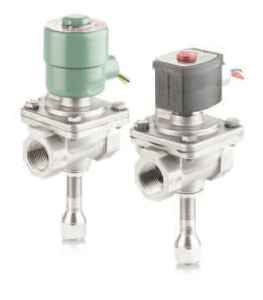by Bob Cadwell, Gerry Longinetti, and James Chiu
A White Paper From ASCO



Low-temperature stainless steel fuel shutoff valves are usually utilized for on/off control of fuel gas within gas fuel trains in process heating system burners. These systems are widely used by oil and gas firms as well as original equipment manufacturers (OEMs) that produce gas heating equipment or burner management systems (BMSs) and controls in upstream oil and gas pipelines and tanks.
These uses present a relatively specialized, rather challenging application for valve manufacturers. Environmental conditions at the point of use are often complex. Ideally, valves should deliver reliable operation despite constraints on factors ranging from power consumption to service availability. Conversely, outdated controls can pose problems — including poor performance, noncompliance with current regulations, and triggering of environmental concerns.
A new generation of solenoid valve technology has been changing the shutoff valve game in recent years. Their modern designs provide pipeline and tank heating systems with robust, durable performance, safety, and regulatory compliance while increasing efficiency and productivity.
A safety shutoff valve plays a crucial role within a heating system. So put: if the valve doesn’t work, neither does the heater. And heater failure can quickly have a mission-critical impact: slowing or halting oil or gas flow in a pipeline, preventing offloading from tank to truck, or stopping the separation of particulates from extracted heavy oil. For the most part, these crucial parts have been pneumatically operated shutoff valves. But OEMs and users have long been unhappy with this increasingly dated technology. These units require pilot valves to control them. And they usually need other equipment and piping at additional expense to operate.
Pneumatically operated valves often use casing gas from the well. So when opened and closed, these valves exhaust methane (a greenhouse gas) into the atmosphere. This burdens users with large carbon footprints that work against campaigns to make oil and gas processing greener. These valves’ relatively high power consumption can be ill-suited for remote pipeline or wellhead tank locations. In addition, many of these valves are not designed to cope with the broad range of supply pressures that differ from site to site on pipeline and tank heating applications. Further, they suffer from relatively high costs. Finally, many installed systems using these older valve technologies are non-compliant with current safety regulations.
Many operators in North America and beyond are moving away from using pneumatically operated shutoff valves on their pipelines and tank heaters. They’re replacing them instead with valves introduced within the last decade by a few manufacturers — all based on solenoid shutoff valve technologies. The design aims of these solenoid valves are easily outlined. They should first be compliant with safety regulations, including both current and pending gas code requirements. They should be more environmentally responsible; unlike pneumatic controls, they shouldn’t vent gas into the atmosphere. This alone would eliminate a source of greenhouse gas emissions and help reduce a users’ overall carbon footprint. In addition, solenoid technology should render them inherently more reliable and deliver substantially longer service life than is possible with pneumatically operated valves. It should also decrease costs by requiring less supporting equipment, lower maintenance levels, and so on. Finally, these solenoid valves should make operation more efficient, saving energy and increasing equipment uptime.
However, even when utilizing the latest solenoid technologies, designing valves for this unique application remains challenging. Surveying the available offerings, it becomes clear that not all solenoid shutoff valves are created equal. Look for models that harness the best technology to maximize efficiency, safety, and service life in harsh or corrosive environments and incorporate the following advantages.
Maintaining tight shutoff in low temperatures represents a particularly demanding design challenge. Doing so while meeting strict regulatory approvals is even more challenging. Also, the remote locations where these valves are often utilized make servicing or replacement exceptionally difficult. Pneumatic controls have long struggled in these conditions.
Today, even some solenoid valves can experience challenges in delivering reliable operation in low temperature environments. Look for valves that are rated for the range of operational temperatures likely to be encountered at your deployed location or locations. For example, ASCO solenoid shutoff valves are rigorously tested in low-temperature conditions, rated to perform down to -40° F (-40° C), and proven to deliver reliable performance under those conditions in installations worldwide.
When specifying gas shutoff valves, pay special attention to operating pressures. Some solenoid valves require a pressure “assist” to open and stay open. If the pressure supply to the valve falls below this minimum pressure differential (often on the order of 3 psi), the valve will close, thus shutting off heat to the pipe or tank. The problem: some sites have inherently low supply pressure. In these locations, solenoid-based shutoff valves requiring a pressure-assist may struggle, cause nuisance shutoffs, or fail to operate at all.
By contrast, valves with lower maximum pressure ratings may be poor fits for sites with high supply pressures. Make sure your valve’s maximum operating pressure rating suits the operating pressures to be encountered at the intended location of your heating system. If you have multiple wells with differing pressure requirements, look for valves that can provide satisfactory service across the most comprehensive possible range of operating pressures. For example, ASCO valves are rated to operate with zero minimum differential pressure. This is a definite plus in environments characterized by low supply pressure, such as remote pipelines or tanks.
As a bonus, valves that handle broad pressures can allow some users to reduce component sizes. Downsizing your fuel train in this way can yield welcome cost savings simply from specifying the correct shutoff valve.
Power is often in short supply at remote installations so that valves may draw electrical power from generators, solar arrays, or battery packs. Also, valves that don’t use wellhead gas for pneumatic power require added equipment such as compressors, filters, regulators, and lubricators. So users prefer control equipment that minimizes
power consumption as much as possible.
Most early solenoid valves utilized in these applications continuously drew over 20 W of power: a distinct drawback for many users. In succeeding years, valve designers re-engineered their products, striving to cut power consumption for remote applications. Almost all models are now much improved. Example: ASCO solenoid shutoff valves provide the lowest power consumption in their class, featuring peak and hold technology that sustains power draw as low as 0.5 W. At this level, with multiple valves, it may even be possible for users to consider downsizing solar panels or batteries.
Before processing, most gas contains some impurities or entrained particulates. These can pose problems for reliable shutoff operations. For example, experience in Canada indicates that clogging due to these particulates was a source of user complaints about solenoid shutoff valves for pipeline and tank heating equipment.
Of course, few solenoid valves can handle really “dirty” gas. But some solenoid valve makers produce more forgiving designs. Example: ASCO offers shutoff valves fitted with an optimized internal pilot orifice designed to perform reliably with wellhead gas.
Safety regulations in many jurisdictions require that valves utilize proof of closure (POC) when used in burner systems within specific firing rates. With POC, electrical contact is provided when the valve seal is fully closed, enabling an electrical signal (contact closure) to be interlocked with the controller safety circuit. Confirming the valve’s closed position is important when starting and stopping more extensive pipeline and tank heating systems.
On BMSs up to 5 million Btu/Hr, some regulations require two shutoff valves used in series (for redundancy) or one shutoff valve with POC. Burner systems from 5 million to 12.5 million Btu/Hr typically require two shutoff valves in series, one with POC. BMSs above 12.5 million Btu/Hr demand two shutoff valves in series, with POC. Until recently, POC was available solely in actuated valve packages. However, users have been trying to move away from these older technologies for reasons already mentioned.
Finally, OEMs and users can find solenoid valves with POC built-in. New ASCO low-temperature stainless steel solenoid shutoff valves with POC are now available — the first of their kind on the market. So users can specify an ASCO valve with POC on their burner systems to help increase savings, performance, and production efficiency.
In North America and around the world, governments have been tightening regulations, and increasingly demanding third-party validation of burner management equipment. Experts predict more regulations in more markets in coming years, plus greater enforcement of regulations already in place — all due to concerns about code compliance, the environment, plus worker and community safety.
This makes it imperative to consult with your manufacturer or supplier, making sure that critical components such as gas shutoff valves meet all appropriate certifications for your application and location.
For example, in Canada, safety shutoff valve standards and regulations include CSA B149.3-10 Field Approval for Fuel Related Components; Automatic Gas Valves Z21.21 CSA 6.5 C/I; C22.2 No. 139 Electrically Operated Valves; and ANSI/ISA 12.27.01 Single Seal. Valves also require Canadian Registration Numbers (CRNs) and must meet provincial inspections. In the U.S., valves are governed by UL (Underwriters Laboratory), FM (Factory Mutual) and NFPA (National Fire Protection Agency) standards.
Users can also help ensure compliance and reliable performance by providing appropriately tested valves. Query a prospective supplier about the development and testing regimen a given valve has undergone: Is it extensive? Does it test all production units, or only a few? Does it subject tested units to extreme conditions? Do tested conditions match those found on your sites?
Note that many inspection agency personnel, when asked by users, give ASCO shutoff valves high marks for compliance and reliability.
Tightening regulations, continuing safety concerns, and industry-wide efforts to achieve greater efficiency are all fueling a move from pneumatic to solenoid shutoff valve technology in heating system applications. Fortunately, ongoing improvements mean this category offers several excellent products that deliver innovative performance benefits.
Evaluate how well a prospective valve meets your site’s and application’s needs for low temperature performance, wide pressure ranges, power consumption savings, proof of closure, regulatory approvals, and more. With careful selection, you can choose a solenoid safety shutoff valve that provides your heating system with regulatory compliance, reliable performance, and savings.
• Safety shutoff valves based on solenoid technology can offer substantial improvements over older air-operated models
• Not all solenoid shutoff valves offer the same level of performance
• Consider these important capabilities when selecting a solenoid shutoff valve: operating temperatures, pressure ranges, power consumption, reliable performance, and proof of closure
• Evaluate prospective solenoid shutoff valve models closely to ensure regulatory compliance with your location and application
Copyright © 2025 Butler & Land Technologies, LLC. All Rights Reserved.
Web Design by Red Spot Design. Return & Refund Policy, Terms & Conditions